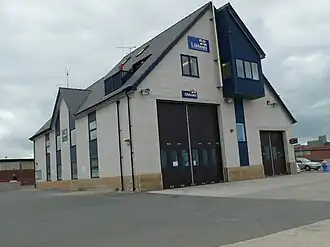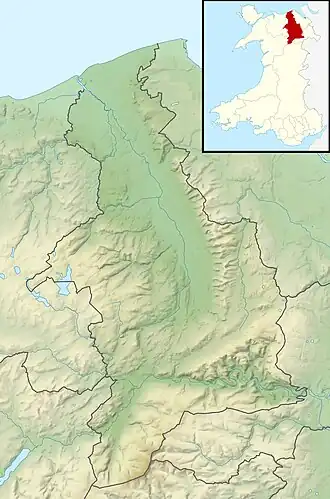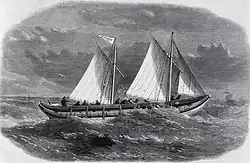Rhyl Lifeboat Station
| Rhyl Lifeboat Station | |
|---|---|
 | |
 Rhyl Lifeboat Station | |
 Rhyl, Denbighshire | |
| General information | |
| Type | RNLI Lifeboat Station |
| Location | East Parade, |
| Town or city | Rhyl, Denbighshire, LL18 3YP |
| Country | Wales, UK |
| Coordinates | 53°19′30.3″N 3°29′20.0″W / 53.325083°N 3.488889°W |
| Opened | 1852 |
| Owner | |
| Website | |
| Rhyl RNLI Lifeboat Station | |
Rhyl Lifeboat Station can be found at East Parade in Rhyl, a seaside town sitting at the mouth of the River Clwyd, on the coast of Denbighshire, North Wales.
A lifeboat was first placed at Rhyl in 1852, by The Shipwrecked Fishermen and Mariners' Royal Benevolent Society (SFMRBS). Management of the station was transferred to the Royal National Lifeboat Institution (RNLI) in 1854.[1]
The station currently operates 13-34 Anthony Kenneth Heard (ON 1341), a Shannon-class All-weather lifeboat (ALB), on station since 2019, and the smaller D-class (IB1) Inshore lifeboat (ILB), Geoff Pearce (D-903), on station since 2025.[2]
History
In 1851, the president of the Royal National Institution for the Preservation of Life from Shipwreck (RNIPLS), Duke of Northumberland, offered a prize of 100 guineas for the best design for a self-righting lifeboat. The prize was won by boatbuilder Mr James Beeching of Great Yarmouth.
On the strength of this award, the Shipwrecked Fishermen and Mariners' Royal Benevolent Society purchased a lifeboat for Rhyl from James Beeching of Great Yarmouth. The boat was a 26-foot x 6-foot 6in self-righting 'Pulling and Sailing' (P&S) lifeboat, one with both sails and (8) oars, and was named Gwylan-y-Mor. A boathouse was constructed between the beach and the river, on the west side of the River Clwyd.[3]
On 22 January 1853, the SFMRBS Rhyl lifeboat Gwylan-y-Mor was launched to the aid of a vessel, thought to be the Lord Ashburton, which had been reported 'de-masted' off West Hoyle. Unable to find the vessel, (reports say the boat later put in at Beaumaris), the lifeboat headed home, but capsized on the return trip. The lifeboat didn't self-right, and six of her nine crew were lost.[4][5][6]
Only 3 months earlier, on 1 October 1852, in another Beeching lifeboat, eight SFMRBS lifeboat crew from Lytham had drowned. The lifeboat didn't self-right after capsize. Afterwards it was discovered that doors had been cut into the airtight boxes for storage, and that the water ballast tanks had not been plugged, allowing the water to escape, thus cancelling any self-righting capability.[7][8]
A damning report was published in the "The Lifeboat", dated 1 December 1852, but apparently published after the Rhyl disaster, highlighting the fact that although both boats carried a brass plaque with "Northumberland Prize Boat", neither had been constructed to the same design or standards.[9]
Although modifications were made to the lifeboat, all confidence in the boat had been lost, and although it was officially on service until 1856, the local committee resolved that the boat would not be used again.[10]
On 5 October 1854, under the guidance of the Duke of Northumberland, the RNIPLS became the Royal National Lifeboat Institution. Just two months later, on 7 December 1854, the SFMRBS handed over the management of all their stations and lifeboats, including Rhyl and Lytham, to the RNLI. This was to allow the SFMRBS to concentrate of the welfare of those people rescued.[11]

On the request of the local committee, and with a view to evaluating its performance, the RNLI commissioned a new design "Tubular" lifeboat, following successful trials of the first boat Challenger, by its inventor H. Richardson, of Bala.[12]
In February 1856, the new 32-foot Tubular lifeboat, constructed by Mr Lees of Manchester, was launched, and towed to Rhyl from Manchester. The lifeboat was constructed using two iron tubes, 32-feet x 2-feet 8in diameter, divided into eight air-tight compartments, and containing 140 cubic feet of air. The tubes were connected together, and supported a deck of 8-feet 4in, sitting approximately 11 inches above the water.[10][13]
It was reported at the meeting of the RNLI committee of management on Thursday 3 September 1867, that the sum of £650 had been received from Miss Ellen Hodgson, executor of the will of the late Mrs Elizabeth Morgan of Cheltenham, for the whole cost of the renovation of the Rhyl lifeboat station in her memory. The lifeboat had recently suffered some damage, and after being sent for repairs, returned to be named Morgan. The lifeboat continued to serve at Rhyl until 1893.[14]
Whilst the Tubular lifeboat was away for repairs, unusually, the relief lifeboat supplied was a brand new lifeboat. Henry Nixson No.2 had been built for the new Abergele Lifeboat Station. Before even reaching its new station, it was diverted to cover at Rhyl. When the tubular lifeboat returned, it had been decided to establish the new station a little further along the coast at Llanddulas, and a lifeboat station was never established at Abergele.[15]
1960s onwards
At 01:17 on 17 September 1962, Rhyl Lifeboat Anthony Robert Marshall (ON 869) was launched on service, to the first lifeboat service to a hovercraft. After a season operating between Rhyl and Hoylake, in a north-west gale, the hovercraft had broken adrift, and was in danger of hitting Rhyl promenade. Unable to attach a line, the coxswain manouvered the lifeboat between Hovercraft and shore, rescuing the three crew, and bringing the hovercraft to harbour an hour later when conditions allowed. For this service, Coxswain Harold Campini was awarded the RNLI Silver Medal.[16][17]
In 1967, the first D-class (RFD PB16) Inshore Lifeboat (D-141) was also put on service in Rhyl, in response to an increasing amount of water-based leisure activity. These were easily launched with just a few people, ideal to respond quickly to local emergencies.[18]
The RNLI Bronze Medal was awarded to Helm Don Archer-Jones in 1973, for the courage and seamanship he displayed, when the ILB rescued two boys cut off by the tide. Both were found clinging to a perch marking the sewer outfall between Rhyl and Prestatyn, in a gale force westerly wind and a rough sea on 7 August. Crew member Paul Frost was awarded a medal service certificate.[19]
The Duke of Kent presented the lifeboat station with an anniversary Vellum in 2002, to celebrate the 150th anniversary of Rhyl Lifeboat Station.
Description
The lifeboat station is built on the promenade in Rhyl. The building contains the All-weather lifeboat (ALB) with Shannon Launch and Recovery System (SLARS), Inshore lifeboat (ILB), launched with a marinised County Tractor, and a Land-Rover Defender, used for Search and Rescue operations off the coast of Rhyl. The station also has a short concrete slipway that leads down to the beach. Each boat is kept on a carriage attached to a tractor which propels it down to the water and brings it back after use. A fundraising shop is situated on the west side of the boathouse.
Area of operation
The Shannon-class All-Weather lifeboat at Rhyl has a top speed of 25 knots (46 km/h). The lifeboat can cover an area from Colwyn Bay (west) to Mostyn (east). North of the station the All-Weather lifeboat covers the Oil and Gas platforms of the Douglas and Hamilton fields, and also the windfarms of North Hoyle; Rhyl Flats; and the Gwynt-Y-Mor fields. Rhyl Lifeboat is a part of the contingency plan for any evacuation of the rigs. The area also covers the outer approaches to Liverpool. Adjacent ALBs are at Llandudno to the west, and Hoylake to the east. There is an ILB station at both Flint and West Kirby to the east.
Notable rescues
- 1962 - ALB, First service ever made by a lifeboat to a hovercraft [20]
- 1973 - ILB, Rescue to children stuck on sewer outfall [21]
- 1990 - Towyn and Pensarn floods [22]
- 2011 - ALB, Rescue kayaker with hypothermia [23]
- 2011 - ILB, Rescue to mother and son with hypothermia [24]
- 2012 - ALB, Rescue to cargo ship in Llanddulas [25]
Station honours
The following are awards made at Rhyl.[1][26]
- Harold Louis Campini, Coxswain – 1962
- Don Archer-Jones, Helm – 1973
- Medal Service Certificate
- Paul Frost, crew member – 1973
- The Thanks of the Institution inscribed on Vellum
- Robert Hughes, Honorary Secretary – 1872[27]
- Rhyl lifeboat crew – 1962
- Donald Jones, Helm – 1974
- Richard Perrin, crew member – 1974
- James Quinn, crew member – 1974
- Framed Letter of Thanks signed by the Chairman of the Institution
- Edward Jones – 1872
- Shore Crew – 1962
- Martin Jones, Mechanic – 2001
- Bruce Arnold Herbert, Coxswain – 1991QBH[28]
- Jean Olive Frost, Manageress of the Rhyl Lifeboat Souvenir Shop – 2008NYH[29]
- Paul Frost, crew member – 2011QBH[30]
- Martin Peter Jones, Coxswain – 2017NYH[31]
Roll of honour
In memory of those lost whilst serving Rhyl lifeboat.[1]
- Lost when the lifeboat capsized and failed to self-right, on service to the Lord Ashburton, 22 January 1853
- John Edwards
- John Evans
- David George
- Phillip Jones
- Thomas Jones
- William Parry
Rhyl lifeboats
No.1 Station
| ON[a] | Name | Built | On Station[32] | Class | Comments |
|---|---|---|---|---|---|
| Pre-244 | Gwylan-y-Môr | 1852 | 1852–1856 | 26-foot Self-righting (P&S) | [Note 1] |
| 70 | Unnamed | 1856 | 1856–1868 | 32-foot Tubular (P&S) | [Note 2] |
| Pre-490 | Henry Nixson No.2 | 1867 | 1868–1869 | 33-foot Self-righting (P&S) | [Note 3]Relief boat whilst ON 70 repaired |
| 70 | Morgan | 1856 | 1869–1893 | 32-foot Tubular (P&S) | |
| 287 | Caroline Richardson | 1891 | 1893–1897 | 35-foot 7in Tubular (P&S) | [Note 4] Previously at Pwllheli |
| 398 | Caroline Richardson | 1896 | 1897–1939 | 34-foot Tubular (P&S) | [Note 5] |
- Pre ON numbers are unofficial numbers used by the Lifeboat Enthusiast Society to reference early lifeboats not included on the official RNLI list.
No.2 Station
| ON[a] | Name | Built | On Station[33] | Class | Comments |
|---|---|---|---|---|---|
| Pre-457 | Jane Dalton | 1866 | 1878–1888 | 33-foot Self-righting (P&S) | [Note 6] Previously Robert Raikes at Brighton |
| 166 | Jane Martin | 1888 | 1888–1899 | 34-foot 2in Self-righting (P&S) | [Note 7] |
- No.2 Station closed in 1899
Motor lifeboats
| ON[a] | Op. No.[b] | Name | On Station[32] | Class | Comments |
|---|---|---|---|---|---|
| 835 | – | The Gordon Warren | 1939–1949 | Surf | |
| 869 | – | Anthony Robert Marshall | 1949–1968 | Liverpool | |
| 993 | 37-22 | Har Lil | 1968–1990 | Oakley | |
| 1000 | 37-29 | Mary Gabriel | 1990–1992 | Rother | |
| 1183 | 12-24 | Lil Cunningham | 1992–2019 | Mersey | |
| 1341 | 13-34 | Anthony Kenneth Heard | 2019– | Shannon | [34] |
Inshore lifeboats
| Op. No.[b] | Name | On Station[35] | Class | Comments |
|---|---|---|---|---|
| D-141 | Unnamed | 1967–1975 | D-class (RFD PB16) | |
| D-243 | Unnamed | 1976–1987 | D-class (Zodiac III) | |
| D-348 | Banks' Staff I | 1987–1995 | D-class (EA16) | |
| D-485 | Stafford with Rugeley | 1995–2004 | D-class (EA16) | |
| D-632 | Godfrey and Desmond Nall | 2004–2014 | D-class (IB1) | |
| D-770 | Mary Maxwell | 2014–2025 | D-class (IB1) | |
| D-903 | Geoff Pearce | 2025– | D-class (IB1) |
Launch and recovery tractors (ALB)
| Op. No.[b] | Reg. No. | Type | On Station[36] | Comments |
|---|---|---|---|---|
| T6 | DM 3318 | Clayton | 1921–1938 | |
| T12 | LLY 75 | Clayton | 1938–1940 | |
| T37 | GGF 497 | Case L | 1940–1954 | |
| T53 | KXT 421 | Case LA | 1954–1955 | |
| T63 | PXF 163 | Fowler Challenger III | 1955–1963 | |
| T60 | OXO 323 | Fowler Challenger III | 1963–1972 | |
| T67 | YLD 792 | Fowler Challenger III | 1972–1974 | |
| T58 | OJJ 312 | Fowler Challenger III | 1974–1975 | |
| T68 | YUV 742 | Fowler Challenger III | 1975–1978 | |
| T60 | OXO 323 | Fowler Challenger III | 1978–1983 | |
| T67 | YLD 792 | Fowler Challenger III | 1983–1984 | |
| T92 | A462 AUX | Talus MB-H Crawler | 1984–1997 | |
| T91 | UAW 558Y | Talus MB-H Crawler | 1997–2007 | |
| T93 | A496 CUX | Talus MB-H Crawler | 2007–2019 | |
| SC-T20 | HF19 EHH | SLARS (Clayton) | 2019– | Violet Rose Saw |
Launch and recovery tractors (ILB)
| Op. No.[b] | Reg. No. | Type | On Station[37] | Comments |
|---|---|---|---|---|
| TA09 | KLG 681Y | Ford 4000 | 1993–1995 | |
| TA25 | PHS 545V | County 1184 | 1995–1998 | |
| TA35 | Q678 BRM | County 1184 | 1998–2003 | |
| TW33 | M562 OUX | Talus MB-764 County | 2002–2006 | |
| TW31 | L526 JUJ | Talus MB-764 County | 2006–2008 | |
| TW44 | S193 RUJ | Talus MB-764 County | 2008–2010 | |
| ST02 | WA54 HRP | Softrak Loglogic | 2010–2012 | |
| TW05 | UJT 151S | Talus MB-764 County | 2012– |
See also
Notes
- ^ 26-foot x 6-foot 6in (8-oared) self-righting (P&S) lifeboat, built by Beeching of Great Yarmouth, costing £116.
- ^ 32-foot x 8-foot 4in (12-oared) Tubular (P&S) lifeboat, built by Lees of Manchester, costing £200.
- ^ 33-foot x 8-foot 6in (10-oared) self-righting (P&S) lifeboat, built by Forrestt of Limehouse, London, costing £292-8s.
- ^ 35-foot 7in x 10-foot (14-oared) Tubular (P&S) lifeboat.
- ^ 34-foot 7in x 8-foot 10in (12-oared) Tubular (P&S) lifeboat, built by Thames Ironworks of Blackwall, London.
- ^ 32-foot x 8-foot 6in (10-oared) self-righting (P&S) lifeboat.
- ^ 34-foot x 8-foot (10-oared) self-righting (P&S) lifeboat.
References
- ^ a b c "Rhyl's station history". Rhyl Lifeboat Station. RNLI. Retrieved 2 June 2025.
- ^ Leonard, Richie; Denton, Tony (2025). Lifeboat Enthusiasts Handbook 2025. Lifeboat Enthusiasts Society. p. 130.
- ^ "Additional Life-Boat Stations". The Lifeboat. I (I): 13. 1 March 1852. Retrieved 4 June 2025.
- ^ A Melancholy Catastrophe 1853
- ^ John Roberts (23 January 1853). "Loss of Another Life Boat". The Times. No. 21334. London. col C, p. 8.
- ^ "Shipping". The Morning Chronicle. No. 26860. London. 25 January 1853.
- ^ "Eight Lives Lost by the Upsetting of a Lifeboat". The Times. No. 21237. London. 4 October 1852. col E, p. 5.
- ^ "Distressing Accident at Lytham. Eight Lives Lost". Daily News. No. 1987. London. 4 October 1852.
- ^ "Lytham and Rhyl Life-Boats". The Lifeboat. I (7): 124. 1 December 1852. Retrieved 5 June 2025.
- ^ a b "Additional Stations, and New Life-Boats". The Lifeboat. II (21): 169–170. 1 July 1856. Retrieved 5 June 2025.
- ^ "A Hundred Years Ago". The Lifeboat. 33 (370). December 1954. Retrieved 19 May 2024.
- ^ "Annual Report". The Lifeboat. II (16): 27. May 1855. Retrieved 5 June 2025.
- ^ Leonard & Denton 2025, pp. 20.
- ^ "Summary of the Meetings of the Committee". The Lifeboat. VI (67): 514. 1 January 1868. Retrieved 12 August 2025.
- ^ Morris, Jeff (May 2006). The Closed Lifeboat Stations of North Wales. Lifeboat Enthusiasts Society. pp. 30–34.
- ^ "First Rescue Ever from a Hovercraft". The Lifeboat. XXXVII (402): 343–344. December 1962. Retrieved 13 August 2025.
- ^ Cox, Barry (1998). Lifeboat Gallantry. Spink & Son Ltd. p. 327. ISBN 0907605893.
- ^ "Inshore Rescue Boats". The Lifeboat. XXXVIII (407): 3. March 1964. Retrieved 21 September 2024.
- ^ Cox 1998, p. 348.
- ^ Rhyl History
- ^ 1973 - Rhyl - Don Archer-Jones
- ^ Towyn floods remembered: 20 years on
- ^ Kayaker rescued five hours after paddling out to windfarm
- ^ Rhyl RNLI volunteers rescue mother and son with hypothermia
- ^ Oil leaks from Carrier off Llanddulas after crew saved
- ^ Cox 1998, pp. 327, 348.
- ^ "Summary of the Meetings of the Committee". The Lifeboat. VIII (67): 399. 1 February 1873. Retrieved 13 August 2025.
- ^ "British Empire Medal (Civil Division)". The Gazette. Retrieved 10 February 2024.
- ^ "Ordinary Members of the Civil Division of the said Most Excellent Order of the British Empire". The Gazette. Retrieved 10 February 2024.
- ^ "Ordinary Members of the Civil Division of the said Most Excellent Order of the British Empire". The Gazette. Retrieved 10 February 2024.
- ^ "Ordinary Members of the Civil Division of the said Most Excellent Order of the British Empire". The Gazette. Retrieved 10 February 2024.
- ^ a b Leonard & Denton 2025, pp. 4–71.
- ^ Leonard & Denton 2025, pp. 10–22.
- ^ Rush, Danielle (7 October 2019). "Historic day planned at Rhyl RNLI to welcome home new £2.5M Shannon". RNLI. Retrieved 10 February 2024.
- ^ Leonard & Denton 2025, pp. 88–98.
- ^ Leonard & Denton 2025, pp. 103–106, 113.
- ^ Leonard & Denton 2025, pp. 109–110, 107–108, 114.
